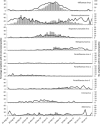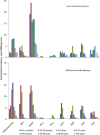Viruses associated with acute respiratory infections and influenza-like illness among outpatients from the Influenza Incidence Surveillance Project, 2010-2011
- PMID: 24338352
- PMCID: PMC5749912
- DOI: 10.1093/infdis/jit806
Viruses associated with acute respiratory infections and influenza-like illness among outpatients from the Influenza Incidence Surveillance Project, 2010-2011
Abstract
Background: The Influenza Incidence Surveillance Project (IISP) monitored outpatient acute respiratory infection (ARI; defined as the presence of ≥ 2 respiratory symptoms not meeting ILI criteria) and influenza-like illness (ILI) to determine the incidence and contribution of associated viral etiologies.
Methods: From August 2010 through July 2011, 57 outpatient healthcare providers in 12 US sites reported weekly the number of visits for ILI and ARI and collected respiratory specimens on a subset for viral testing. The incidence was estimated using the number of patients in the practice as the denominator, and the virus-specific incidence of clinic visits was extrapolated from the proportion of patients testing positive.
Results: The age-adjusted cumulative incidence of outpatient visits for ARI and ILI combined was 95/1000 persons, with a viral etiology identified in 58% of specimens. Most frequently detected were rhinoviruses/enteroviruses (RV/EV) (21%) and influenza viruses (21%); the resulting extrapolated incidence of outpatient visits was 20 and 19/1000 persons respectively. The incidence of influenza virus-associated clinic visits was highest among patients aged 2-17 years, whereas other viruses had varied patterns among age groups.
Conclusions: The IISP provides a unique opportunity to estimate the outpatient respiratory illness burden by etiology. Influenza virus infection and RV/EV infection(s) represent a substantial burden of respiratory disease in the US outpatient setting, particularly among children.
Keywords: acute respiratory illness; epidemiology; influenza; influenza-like illness; respiratory virus; seasonality.
Figures



References
-
- Thompson WW, Comanor L, Shay DK. Epidemiology of seasonal influenza: use of surveillance data and statistical models to estimate the burden of disease. J Infect Dis. 2006;194(Suppl 2):S82–91. - PubMed
-
- Neuzil KM, Maynard C, Griffin MR, Heagerty P. Winter respiratory viruses and health care use: a population-based study in the northwest United States. Clin Infect Dis. 2003;37:201–7. - PubMed
Publication types
MeSH terms
Grants and funding
LinkOut - more resources
Full Text Sources
Other Literature Sources
Medical

